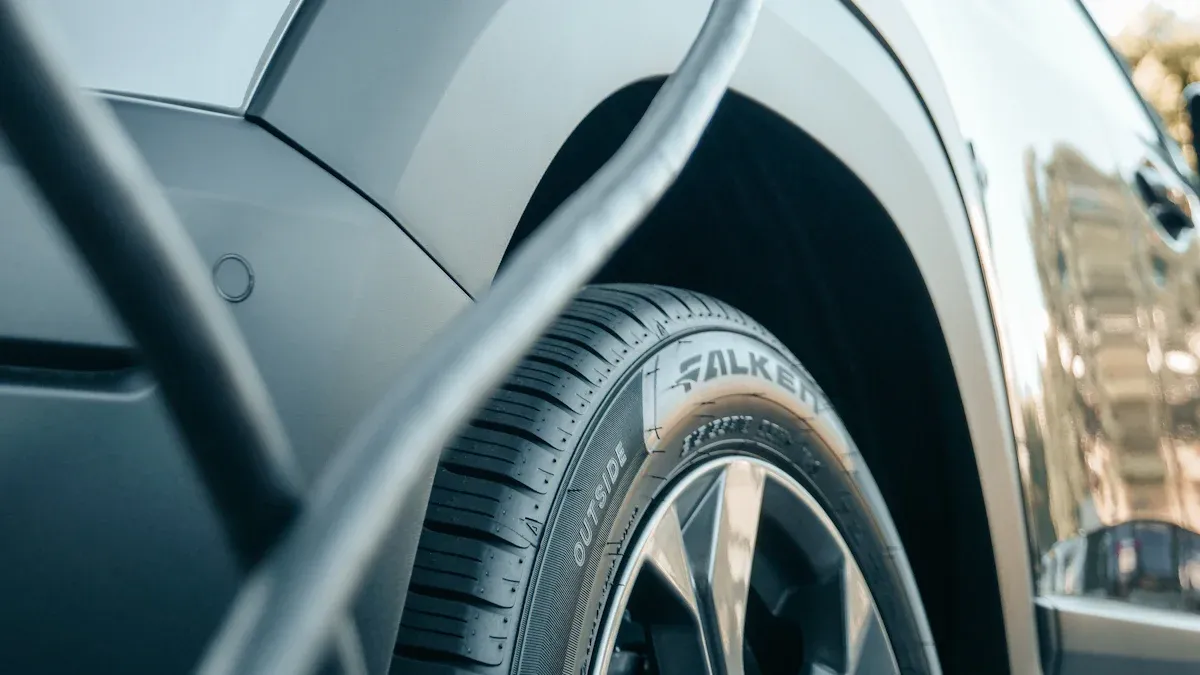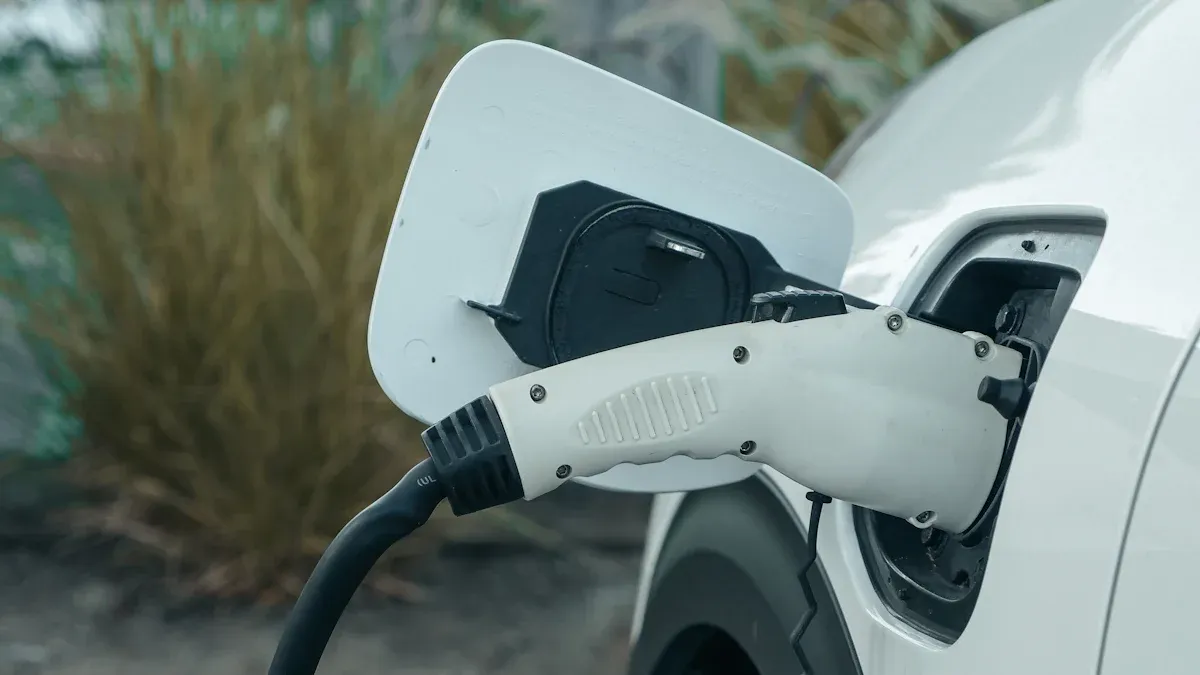
Electric vehicles are transforming the global automotive industry. In 2022, battery demand surged by 65%, with the U.S. witnessing an 80% growth, driven by a 55% rise in EV sales. The SiC Coating technology plays a crucial role in this evolution, addressing the growing need for efficient, durable components in the sic coating car sector. This innovative sic coating auto solution ensures robust infrastructure to support expanding markets like China and Europe. Furthermore, understanding the sic coating process is essential for manufacturers looking to capitalize on the booming sic coating market, which is set to grow alongside the electric vehicle industry.
Key Takeaways
- SiC Coating helps control heat in EV chargers. It stops overheating and makes charging more efficient during high power use.
- The coating protects against rust, keeping connectors and cables strong and reliable in tough conditions.
- SiC Coating makes fast chargers work better. It allows quicker charging and supports the rising need for electric cars.
Challenges Faced by EV Charging Components
Heat and Thermal Stress
EV charging components often face significant heat and thermal stress, especially during high-power charging sessions. High charging currents in HPC DC systems generate substantial heat, which can lead to overheating if not managed effectively. For instance, the C-rate and charge/discharge current directly influence the heat produced during charging. Additionally, the state of charge (SOC) impacts internal resistance, further contributing to thermal challenges.
| Factor | Description |
|---|---|
| C-rate | Influences the amount of heat generated by the battery. |
| Charge/Discharge Current | Affects the electrochemical reactions and heat production. |
| State of Charge (SOC) | Linked to lithium-ion diffusion and impacts internal resistance. |
| Optimal Temperature Range | 20–40 °C is ideal for lithium battery cells to maintain performance. |
Without proper thermal management, components like connectors and cables may experience heat losses, reducing efficiency. SiC Coating offers a solution by enhancing thermal conductivity and protecting components from excessive heat buildup.
Corrosion and Environmental Exposure
Exposure to harsh environmental conditions, such as moisture, salt, and temperature fluctuations, poses a significant challenge for EV charging components. Corrosion can degrade connectors and cables, leading to poor electrical conductivity and increased maintenance costs. Infrastructure limitations exacerbate this issue, as many charging stations lack adequate protection against environmental factors. Innovative solutions, such as SiC Coating, provide a robust barrier against corrosion, ensuring long-term durability and reliability in diverse climates.
Electrical Stress and Wear Over Time
Electrical stress from continuous use and high-power charging can accelerate the wear and tear of EV charging components. Studies reveal that Level 2 charging imposes a higher aging impact on transformers compared to Level 1 charging. At a 50% penetration level, 50% of 25 kVA transformers and 35% of 50 kVA transformers experience overloading, reducing their lifespan. This stress also affects cables and connectors, leading to frequent replacements. SiC Coating mitigates these effects by improving the electrical insulation and wear resistance of components, ensuring consistent performance over time.
SiC Coating Technology: A Game-Changer

What is Silicon Carbide (SiC)?
Silicon Carbide (SiC) is a semiconductor material known for its exceptional thermal and mechanical properties. It has a specific density of 3.21 g/cm³ and a high fracture toughness of 6.8 MPa m0.5, making it highly durable. SiC also boasts a Young’s modulus of 440 GPa, indicating its rigidity and resistance to deformation. Its thermal conductivity of 120 W/m•K and low coefficient of thermal expansion (4.0 x10–6/°C) make it ideal for high-temperature applications. Additionally, with a hardness of 32 GPa, SiC ranks among the hardest materials, offering superior wear resistance. These characteristics make it a preferred choice for demanding applications, including EV charging components.
Key Properties of SiC Coating
SiC Coating leverages the inherent properties of Silicon Carbide to enhance the performance of EV charging components. Its high thermal conductivity ensures efficient heat dissipation, reducing the risk of overheating during high-power charging. The coating’s exceptional hardness and wear resistance protect components from mechanical damage and extend their lifespan. Furthermore, its low thermal expansion minimizes stress caused by temperature fluctuations, ensuring structural stability. SiC Coating also provides a robust barrier against environmental factors like moisture and corrosion, making it suitable for diverse operating conditions.
How SiC Coating Solves EV Charging Challenges
SiC Coating addresses critical challenges in EV charging infrastructure by improving efficiency, durability, and reliability. For instance, advanced SiC solutions enhance the efficiency of DC fast charging systems, ensuring consistent performance under high-power conditions. The coating’s ability to withstand thermal and electrical stress reduces wear and tear, minimizing maintenance requirements. Additionally, its corrosion-resistant properties protect connectors and cables from environmental exposure, ensuring long-term functionality. Industry experts recognize SiC’s transformative role in overcoming these challenges, making it a cornerstone of modern EV technology.
| Topic | Description |
|---|---|
| Efficiency in EV Charging | Advanced SiC solutions improve efficiency and reliability in charging systems. |
| Industry Impact | SiC plays a transformative role in addressing challenges in EV infrastructure. |
Applications of SiC Coating in EV Charging Components
Power Inverters
Power inverters play a critical role in converting DC power from EV batteries into AC power for the motor. These components operate under high thermal and electrical stress, which can compromise their efficiency and lifespan. SiC Coating enhances the performance of power inverters by providing superior thermal management and electrical insulation. For example, studies show that SiC-coated electric vehicle power modules achieve a 5-7% efficiency improvement, extending the driving range by up to 10%. Additionally, SiC coatings enable inverters to withstand operational temperatures of up to 250˚C, ensuring reliability in demanding conditions. This makes them indispensable for modern EV powertrains.
| Application Area | Performance Improvement |
|---|---|
| Electric vehicle power modules | 5-7% efficiency improvement, extending driving range by up to 10% |
| Semiconductor manufacturing | Components withstand thermal cycles exceeding 1,600°C |
Connectors and Cables
Connectors and cables are essential for transmitting power between charging stations and EVs. However, they are often exposed to harsh environmental conditions, including moisture, salt, and temperature fluctuations, which can lead to corrosion and wear. SiC Coating provides a robust barrier against these elements, ensuring long-term durability and optimal electrical conductivity. Regulatory standards, such as ISO 6469 and UN Regulation No. 100, emphasize the importance of dielectric coatings for insulation and safety in high-voltage components. By meeting these requirements, SiC Coating ensures that connectors and cables remain reliable even in extreme climates.
- Key Benefits of SiC Coating for Connectors and Cables:
- Protection against corrosion and environmental damage.
- Enhanced electrical insulation for high-voltage safety.
- Compliance with international regulatory standards.
Fast Charging Systems
Fast charging systems are pivotal for reducing EV charging times and supporting the growing adoption of electric vehicles. These systems operate at high voltages and generate significant heat, which can strain components. SiC Coating addresses these challenges by improving thermal conductivity and managing high-voltage loads effectively. Research highlights the role of SiC in enhancing the efficiency and performance of fast-charging systems, making them safer and more reliable. As the automotive industry shifts toward high-power semiconductors like SiC, these coatings will remain integral to advancing fast-charging technology and meeting the demands of the EV market.
Note: SiC Coating not only improves the performance of fast-charging systems but also contributes to the broader goal of sustainable mobility by enabling faster and more efficient charging solutions.
Benefits of SiC Coating for EV Charging Components

Enhanced Thermal Management
SiC Coating significantly improves thermal management in EV charging components. Its high thermal conductivity ensures efficient heat dissipation, reducing the risk of overheating during high-power charging sessions. Studies on Al/SiC functionally graded coatings highlight its ability to maintain performance across a wide temperature range. Key findings include:
- Numerical simulations conducted at impact energy levels of 260 J across temperatures from 298 K to 773 K.
- Average coating thickness measured at 232.8 μm, ensuring consistent thermal performance.
This advanced thermal management capability allows EV charging systems to operate reliably under extreme conditions, enhancing their overall efficiency and safety.
Improved Durability and Longevity
The exceptional hardness and wear resistance of SiC Coating protect EV charging components from mechanical damage and environmental stress. Its robust barrier against corrosion ensures long-term durability, even in harsh climates. By minimizing wear and tear, SiC Coating extends the lifespan of critical components like connectors, cables, and power inverters. This durability reduces maintenance costs and downtime, making it a cost-effective solution for EV infrastructure.
Increased Efficiency and Performance
SiC Coating enhances the efficiency and performance of EV charging systems by leveraging the unique properties of wide-bandgap (WBG) materials. The following metrics demonstrate its impact:
| Efficiency Metric | Description |
|---|---|
| Improved Efficiency | WBG devices exhibit lower on-resistance and switching losses, enhancing power conversion efficiency. |
| Faster Switching Speeds | Enables switching frequencies up to 10 times higher than silicon due to superior electron mobility. |
| Higher Voltage Operation | Capable of handling much higher voltages in smaller devices due to a higher breakdown field. |
These advancements enable faster charging speeds and higher voltage operations, meeting the growing demands of the EV market. SiC Coating plays a pivotal role in optimizing system performance, ensuring reliable and efficient energy transfer.
Future Trends in EV Technology and the Role of SiC Coating
Supporting Higher Voltage Systems
The automotive industry is transitioning to higher voltage systems, with EV batteries advancing from 400 V to 800 V and even 1,250 V specifications. These higher voltages enable faster power transfer, reducing energy losses and improving charging efficiency. For instance, the SAE J3271 standard supports charging at 1,250 VDC, delivering up to 3.75 MW with active cooling. Silicon Carbide (SiC) technology plays a pivotal role in this evolution. SiC MOSFETs, with their lower on-resistance and faster switching speeds, enhance energy efficiency while supporting higher voltage operations. Additionally, SiC devices simplify thermal management by tolerating higher temperatures, reducing the need for complex cooling systems. This advancement allows for thinner, lighter cables, contributing to longer driving ranges and more efficient EV designs.
| Aspect | Details |
|---|---|
| Voltage Levels | EVs are advancing to 400 V, 800 V, and 1,250 V specifications. |
| Efficiency Gains | Higher voltages reduce energy losses and enable faster charging. |
| SiC Advantages | Lower on-resistance, faster switching, and better thermal management. |
Enabling Faster Charging Speeds
SiC technology is revolutionizing EV charging by enabling faster charging rates. Its ability to handle higher voltages and reduce power losses ensures efficient energy transfer. For example, the transition to 800 V infrastructure, combined with SiC’s efficiency, allows for ultra-fast charging. This innovation reduces waiting times for EV owners and supports long-distance travel. SiC-based chargers also feature compact designs, freeing up space within vehicles. Furthermore, the lightweight components enabled by SiC contribute to increased energy efficiency, allowing vehicles to travel farther per kilowatt-hour. These advancements make SiC indispensable for the future of EV charging systems.
- SiC supports 800 V infrastructure, enabling ultra-fast charging.
- Its efficiency reduces the size of components and cooling systems.
- Lighter vehicles and improved energy efficiency enhance charging rates.
Contribution to Sustainable Mobility
SiC Coating contributes significantly to sustainable mobility by optimizing EV performance and reducing environmental impact. Its role in enabling higher voltage systems and faster charging speeds directly supports the adoption of electric vehicles. By improving energy efficiency, SiC reduces the carbon footprint of EVs, aligning with global sustainability goals. Additionally, the durability and longevity provided by SiC Coating minimize the need for frequent replacements, reducing waste and conserving resources. As governments and consumers prioritize eco-friendly solutions, SiC technology will remain a cornerstone of sustainable automotive innovation.
Note: SiC Coating not only enhances EV performance but also aligns with the broader vision of a greener, more sustainable future.
SiC Coating is transforming the electric vehicle industry by solving critical challenges in charging components. Its advanced properties enhance durability, efficiency, and reliability, making it essential for modern automotive technology. Ningbo VET Energy Technology Co. continues to lead innovation in SiC Coating solutions, driving the future of EV technology and sustainable mobility.
FAQ
What makes SiC Coating essential for EV charging components?
SiC Coating enhances thermal management, durability, and efficiency. Its unique properties ensure reliable performance under high stress, making it indispensable for modern EV infrastructure.
Can SiC Coating improve fast-charging systems?
Yes, SiC Coating supports higher voltages and faster energy transfer. It reduces heat buildup and power losses, enabling safer and more efficient fast-charging solutions.
How does SiC Coating contribute to sustainability?
SiC Coating extends component lifespan, reduces waste, and improves energy efficiency. These benefits align with global sustainability goals and promote eco-friendly automotive innovation.
Tip: SiC Coating is a forward-thinking solution for manufacturers aiming to future-proof EV technology.






